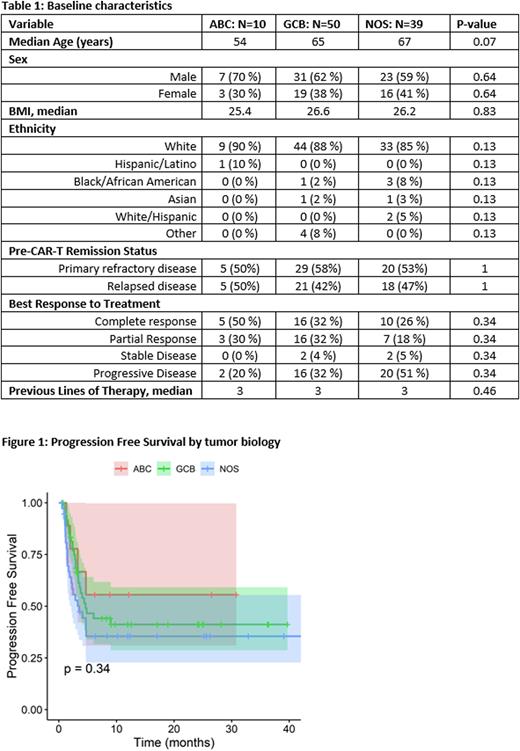Abstract
Introduction: Diffuse large B-cell lymphoma (DLBCL) is the most common subtype of non-Hodgkin lymphoma (NHL), accounting for 30-40% of NHL cases with an incidence of 7 cases per 100,000 persons per year (Susanibar-Adaniya, 2021). There are two major subtypes of DLBCL based on the cell of origin (COO), germinal center B-cell-like (GCB) and activated B-cell-like (ABC). Around 10-15% of cases are unable to be classified and are termed not otherwise specified (NOS). GCB is generally associated with a more favorable prognosis, showing 3-year progression free survival (PFS) rates of approximately 75% compared to 40-50% for ABC (Sehn, 2021).
Chimeric antigen receptor (CAR)-T cell therapy has shown significant responses in relapsed or refractory diffuse large B-cell lymphoma (DLBCL).These treatments have shown objective response rates (ORR) of 52-83% and complete response (CR) rates of 39-58% in relapsed or refractory DLBCL (Abramson, 2020; Locke, 2019; Schuster, 2019; Schuster, 2021). While the CAR-T studies noted the number of patients in the GCB and ABC subtypes, differences in outcomes stratified by subtypes are less well defined.
Methods: This is a retrospective, multi-center (Utah, Michigan, North Carolina) study evaluating outcomes of patients with DLBCL treated with CAR-T cell therapies. The primary outcome of this study is PFS at 12 months based on tumor biology (ABC, GCB, NOS). Secondary outcomes include PFS at 6 months, PFS, overall survival (OS) at 6 months, OS at 12 months, OS, and best response to treatment. Kaplan-Meier curves were created for OS and PFS stratified by DLBCL subtype. Patient characteristics and best response to treatment were summarized stratified by DLBCL subtype and compared by Wilcoxon Rank Sum Test or Chi-square test.
Results: A total of 99 patients were included in this study. Of these, most were GCB subtype (n=50), followed by NOS (n=39), and ABC (n=10). There was no difference is baseline characteristics between each of these groups (Table 1). The median age was 65 years old, 87% were white, and 62% were male. Patients had received a median of 3 prior lines of treatment prior to CAR-T. The median PFS was not achieved for the ABC subtype, 4.6 months for the GCB subtype, and 3.5 months for those who were NOS (p=0.34) (Figure 1). Median OS was 14.8 months, 13.4 months, and 8 months for ABC, GCB, and NOS, respectively (p=0.083). The complete response rates were: ABC subtype (50%), compared to GCB (32%), and NOS (26%) groups (p=0.34). Progressive disease following CAR-T treatment rates were: NOS (51%), compared to ABC (20%) and GCB (32%) groups (p=0.34).
Discussion: The data from this retrospective, multi-center study suggests there may be a trend towards a greater PFS benefit for those with the ABC subtype compared to the GCB and NOS groups. The ABC subtype also showed a numerically higher percentage of complete responses compared to the other groups, but neither were statistically significant differences. The limited number of patients in the ABC group limits the ability to determine a meaningful result currently. There are several limitations of this study. There was a limited sample size in this study, and as a result, statistical significance was unable to be achieved in this analysis. In addition, the percentage of patients in the NOS group in this study (~39%) was much higher than the number reported in the literature (~10-15%). This could be due to the retrospective nature of the study making it difficult to obtain cell of origin information from the time the diagnosis was made and leading to a patient being classified as NOS when they may have had a GCB or ABC subtype.
Our study suggests a potential difference seen to treatment with CAR-T therapy based on the tumor biology of the disease. Future studies with a larger cohort to elucidate a difference in CAR-T therapy responses by cell of origin in DLBCL are warranted as this may influence patient treatment selection.
Disclosures
Wagner:Abbvie Inc.: Other: Partner is currently employed as a Medical Science Liaison . Patel:CareDx: Honoraria; Orca Bio: Research Funding; Kite: Honoraria; Medexus Pharma: Honoraria.
Author notes
Asterisk with author names denotes non-ASH members.


This feature is available to Subscribers Only
Sign In or Create an Account Close Modal